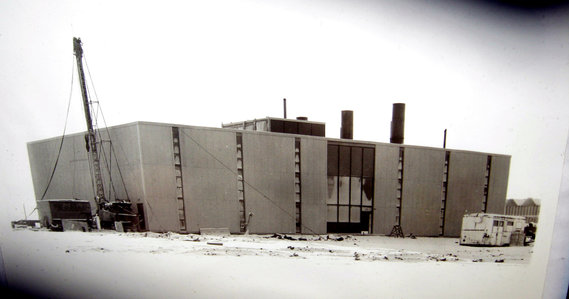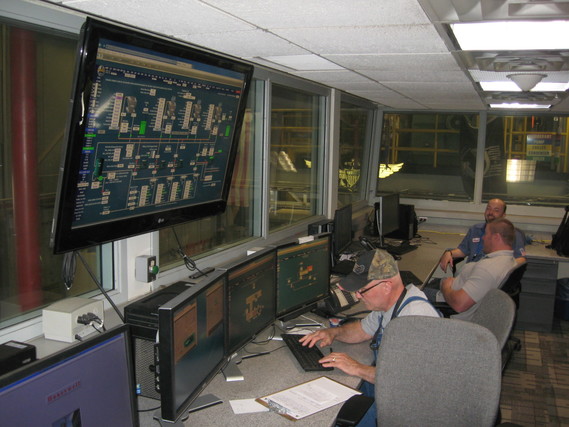|
The Energy Management Center (EMC) at Minneapolis-St. Paul International Airport plays a key role in the airport’s embrace of sustainable practices, as its energy production and monitoring systems have become more modern, efficient operations.
While the current EMC has been heating and cooling the airport since MSP’s Terminal 1-Lindbergh opened in 1962, recent years have led to extensive improvements.
Those include new, efficient equipment, the addition of an electronic monitoring system and an eye for detail that, for example, led to a new line of efficient air filters.
 The Energy Management Center in 1962 when it first opened. Terminal 1-Lindbergh is visible on the far right.
“The system is all about customer comfort,” said Jamie Chatelle, the EMC’s chief engineer.
Since its opening 55 years ago, the EMC’s boiler room has been staffed 24/7. The EMC stayed put as the airport expanded and is now practically invisible to the traveling public, as it’s surrounded by portions of Concourse C.
Behind the scenes, though, the EMC and its 23 employees work around the clock to provide heating and cooling for all of the buildings operated by the Metropolitan Airports Commission (MAC) on the MSP campus.
That includes both terminals, two fire stations, the general offices building, the field maintenance and trades complex on 28th Avenue, the old Navy building, fuel islands and the glycol management building.
Altogether, the EMC heats and cools approximately 4.4 million square feet of interior space -- the equivalent of about 77 football fields, including the end zones.
One of the most recent changes involves a new type of air filter that is used on the numerous forced air units located around the airport. The filters, made by Camfil, allow better air flow but still capture particulates. And they last longer than the earlier generation.
Also, when the Camfil filters need to be replaced, Chatelle said, they can be burned for energy, a change from the previous air filters.
The EMC is also a critical part of the MAC’s energy conservation program, implemented in 1998. Over time, the program has reduced the airport’s carbon footprint by 30 percent and saved $4.2 million in energy costs.
 The control room of the Energy Management Center.
Projects completed as part of the conservation program include the move to LED lights in the airport parking ramps at Terminal 1 and Terminal 2, replacing almost 8,000 metal halide fixtures.
The EMC’s original boilers were replaced more than a decade ago with more efficient models. The chillers that cool the water that is then piped around the airport for air conditioning were upgraded in the mid-1990s.
Also, in the late 1990s, cooling towers were installed on the EMC, enabling the center to stop using well water as a water source.
In addition to the public areas of the airport, the EMC also cools about 200 computer and telecommunications equipment rooms in numerous buildings. The rooms are small but generate disproportionate amounts of heat. During Minnesota winters, chilled outside air is pumped in to cool those areas, another sustainable practice.
The EMC also uses an intelligent monitoring and control system (IMACS) that’s connected to all of the energy-related systems and equipment at the airport.
The system has been modified in recent years to bring more pieces of the EMC’s equipment on board across the MSP campus. Parts of the monitoring system -- made by different manufacturers, such as Siemens and Honeywell -- can now talk to each other. The EMC staff monitors trends on how efficiently certain equipment performs and retains the data for analysis.
The IMACS system’s integration will eventually extend across the heating-ventilation and air conditioning system, plumbing, information technology, steam, jet fuel, lighting, water, natural gas and electric metering systems.
Each system is currently in some state of integration, with most about 70 percent complete.
And the system keeps growing and evolving, Chatelle said. The MAC’s plumbers and electricians tap into IMACS, for example, for remote water metering and electrical switch monitoring, as well as lighting control.
IMACS allows the EMC to reduce operating costs while improving reliability, and that trend is expected to continue as technology is upgraded across the various systems.
With 1 million data points to manage, the EMC plays a critical role in the MAC’s work towards an increasingly sustainable airport system.
|